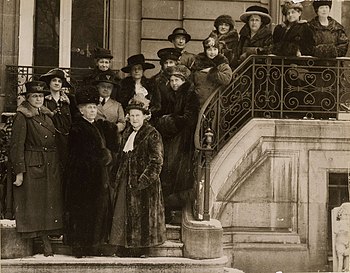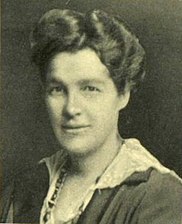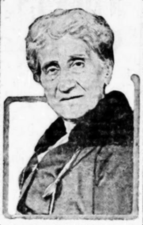
The Paris Peace Conference was a set of formal and informal diplomatic meetings in 1919 and 1920 after the end of World War I, in which the victorious Allies set the peace terms for the defeated Central Powers. Dominated by the leaders of Britain, France, the United States and Italy, the conference resulted in five treaties that rearranged the maps of Europe and parts of Asia, Africa and the Pacific Islands, and also imposed financial penalties. Germany, Austria-Hungary, Turkey and the other losing nations were not given a voice in the deliberations; this later gave rise to political resentments that lasted for decades. The arrangements made by this conference are considered one of the great watersheds of 20th-century geopolitical history.

Fannie Fern Andrews (Phillips), PhD (1867–1950) was an American lecturer, teacher, social worker, and writer.

Doris Stevens was an American suffragist, woman's legal rights advocate and author. She was the first female member of the American Institute of International Law and first chair of the Inter-American Commission of Women.

The International Congress of Women was created so that groups of existing women's suffrage movements could come together with other women's groups around the world. It served as a way for women organizations across the nation to establish formal means of communication and to provide more opportunities for women to ask the big questions relating to feminism at the time. The congress has been utilized by a number of feminist and pacifist events since 1878. A few groups that participated in the early conferences were The International Council of Women, The International Alliance of Women and The Women's International League for Peace and Freedom.

The Open Christmas Letter was a public message for peace addressed "To the Women of Germany and Austria", signed by a group of 101 British suffragists at the end of 1914 as the first Christmas of the First World War approached. The Open Christmas Letter was written in acknowledgment of the mounting horror of modern war and as a direct response to letters written to American feminist Carrie Chapman Catt, the president of the International Woman Suffrage Alliance (IWSA), by a small group of German women's rights activists. Published in January 1915 in Jus Suffragii, the journal of the IWSA, the Open Christmas Letter was answered two months later by a group of 155 prominent German and Austrian women who were pacifists. The exchange of letters between women of nations at war helped promote the aims of peace, and helped prevent the fracturing of the unity which lay in the common goal they shared, suffrage for women.

Jessie Chrystal Macmillan was a suffragist, peace activist, barrister, feminist and the first female science graduate from the University of Edinburgh as well as that institution's first female honours graduate in mathematics. She was an activist for women's right to vote, and for other women's causes. She was the second woman to plead a case before the House of Lords, and was one of the founders of the Women's International League for Peace and Freedom.
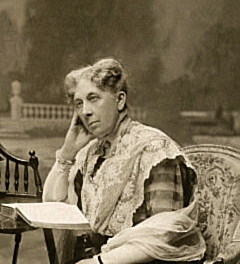
Marguerite de Witt-Schlumberger was a French campaigner for pronatalism, alcoholic abstinence, and feminism. She was the president of the French Union for Women's Suffrage movement. She married into the Schlumberger family and became a powerfully influential matriarch and the mother of several sons who achieved notability in their own right. An activist in international women's rights circles, Witt-Schlumberger was a leading suffragist at the Paris Peace Conference in 1919. For her active involvement and service to the government, she was awarded the Croix of the French Legion of Honour in 1920.

The Second International, also called the Socialist International, was an organisation of socialist and labour parties, formed on 14 July 1889 at two simultaneous Paris meetings in which delegations from twenty countries participated. The Second International continued the work of the dissolved First International, though excluding the powerful anarcho-syndicalist movement. While the international had initially declared its opposition to all warfare between European powers, most of the major European parties ultimately chose to support their respective states in World War I. After splitting into pro-Allied, pro-Central Powers, and antimilitarist factions, the international ceased to function. After the war, the remaining factions of the international went on to found the Labour and Socialist International, the International Working Union of Socialist Parties, and the Communist International.
The First International Congress of Working Women (ICWW), convened by the Women's Trade Union League of America from October 28 to November 6, 1919, was a meeting of labor feminists from around the world. The ICWW planned to share their proposals for addressing women's labor concerns at the First International Labor Conference (ILC) of 1919. ICWW delegates agreed upon a list of resolutions, some of which were taken up by the ILC's Commission on the Employment of Women and resulted in the passage of the Maternity Protection Convention, 1919.

The Seventh Conference of the International Woman Suffrage Alliance met in Budapest, Hungary, 15–21 June 1913. As had been the case with all the preceding International Woman Suffrage Alliance conferences, the location had been chosen to reflect the status of woman suffrage: a place where the prospects seemed favorable and liable to influence public sentiment by demonstrating that it was now a global movement. When it had been announced at the sixth congress that the next one would be held in the capital of Hungary, it was felt that the location seemed very remote, and there were concerns that Hungary did not have representative government. In fact, it proved to be one of the largest and most important conventions. Furthermore, the delegates stopped en route for mass meetings and public banquets in Berlin, Dresden, Prague and Vienna, spreading its influence ever further afield.

Lilly Rose Cabrera, Marquise of Ter and Countess of Morella, known as the Marquesa del Ter, was the wife of the 2nd Marquis of Ter and 2nd Count of Morella, Ramón Cabrera y Richards. Born in Paris, she was a pianist and feminist who founded one of the first feminist organizations in Spain. She was awarded the Gold Médaille de la Reconnaissance française for her work with hospitals during World War I.
This is a listing of noteworthy historical events relating to the international women's movement which occurred in 1919.
Alice Schiavoni Bosio was an Italian suffragette. She served as the director of the journal Attività Femminile Sociale from its founding in 1913 through 1916. Affiliated with the Consiglio Nazionale delle Donne Italiane, a member of the International Council of Women, Schiavoni was one of the participants in both the Women at the Hague Conference of 1915 and the Inter-Allied Women's Conference of 1919.
Ruth Atkinson was a New Zealand activist who was involved in the Temperance movement and women's rights movement. From 1910 until her death was the president of the Women's Christian Temperance Union of New Zealand branch in Nelson. In 1919, she was chosen by the organization to participate in the Inter-Allied Women's Conference, a parallel conference to the 1919 Paris Peace Conference.
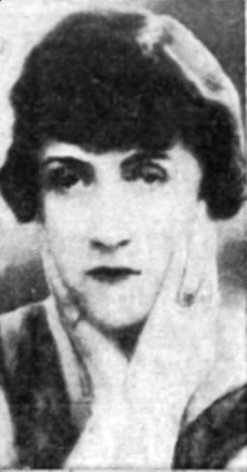
Valentine Mathilde Amélie Thomson was an influential French journalist, playwright and editor, who was active both in Europe and the United States. Daughter of the left-wing politician Gaston Thomson, in 1919 she was a delegate at the Inter-Allied Women's Conference which sought to introduce women's issues to the peace process following the end of the First World War. In Paris, in collaboration with her husband, the journalist and screenwriter André Jaeger-Schmidt (1884–1940), she wrote plays which were staged in Paris and the provinces. In the late 1920s she moved to the United States where she wrote about international politics for a variety of papers including the New York Times and Harper's Magazine. She was also known for the salons she held with prominent figures of her times.
Eugénie Beeckmans was a trade unionist and women's rights advocate. In 1913, she was appointed to the Conseil supérieur de l'enseignement technique for the French Republic. She was one of the delegates to the Inter-Allied Women's Conference, a parallel congress to the 1919 Paris Peace Conference and participated in the 18 March presentation to the Labour Commission of the Peace Conference regarding working conditions faced by women labourers. She served as the inaugural president of the Fédération des Syndicats professionnels du Vêtement of the Confédération Française des Travailleurs Chrétiens (CFTC) from its founding in 1921 until 1937. In 1921, she represented the Syndicat de l’Abbaye at the Second CFTC Congress. She was elected as a member of the Confederal Bureau of the General Confederation of Labour in 1921 and re-elected in 1925, and from 1922 to 1924 served on their national council. In 1923, together with Maria Bardot, she successfully negotiated the first collective labour agreement for female garment workers, providing a basis for better wages and for expanding union membership. In the period between the two world wars, as an influential member of the CFTC, she is considered to be among the most striking representatives of women's Christian militarism in France.

Alma Maria Katarina Sundquist (1872–1940) was a Swedish physician and a pioneering female specialist in the treatment of venereal diseases. A committed women's rights activist, she campaigned for better working conditions for women, addressed problems associated with unhygienic homes and prostitution, and promoted the need for sexual education for girls. She fought for women's suffrage, contributing to the inaugural meeting of the Swedish Association for Women's Suffrage (FKPR) in June 1902. Internationally, in 1919 she represented Sweden at the founding of the Medical Women's International Association in New York and attended the First International Congress of Working Women in Washington, D.C. In the early 1930s, on behalf of the League of Nations, she was one of the three contributors to a report on the slave trade in women and children in the countries of Asia.
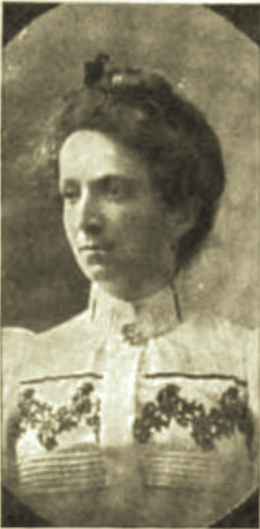
Jane Agnes Stewart was an American author, editor, and contributor to periodicals. She was a special writer for many journals on subjects related to woman's, religious, educational, sociological, and reform movements. Stewart was a suffragist and temperance activist. She traveled to London, Edinburgh, and Paris as a delegate of world's reform and religious conventions.

Lillian GonzalesKohlhamer, also known as Lillian Gottlieb Kohlhamer, was an American suffragist and peace activist, based in Chicago. She was one of the American delegates to the International Congress of Women held in The Hague in 1915, and at the International Woman Suffrage Alliance conference in Geneva in 1920.

Eugénie Hamer was a Belgian journalist, writer and activist. Her father and brother served in the Belgian military, but she was a committed pacifist. Involved in literary and women's social reform activities, she became one of the founders of the Alliance Belge pour la Paix par l'Éducation in 1906. The organization was founded in the belief that education, political neutrality, and women's suffrage were necessary components to peace. She was a participant in the 18th Universal Peace Congress held in Stockholm in 1910, the First National Peace Congress of Belgium held in 1913, and the Hague Conference of the International Congress of Women held in the Netherlands in 1915. This led to the creation of the International Committee of Women for Permanent Peace, subsequently known as the Women's International League for Peace and Freedom (WILPF). Hamer co-founded the Belgian chapter of the WILPF that same year. During World War I, she volunteered as a nurse and raised funds to acquire medical supplies and create an ambulance service.
